The NVIDIA GeForce GTX 780 Ti Review
by Ryan Smith on November 7, 2013 9:01 AM ESTCompute
Jumping into compute, we’re entering the one area where GTX 780 Ti’s rule won’t be nearly as absolute. Among NVIDIA cards its single precision performance will be unchallenged, but the artificial double precision performance limitation as compared to the compute-focused GTX Titan means that GTX 780 Ti will still lose to GTX Titan whenever double precision comes into play. Alternatively, GTX 780 Ti still has to deal with the fact that AMD’s cards have shown themselves to be far more competitive in our selection of compute benchmarks.
As always we'll start with our DirectCompute game example, Civilization V, which uses DirectCompute to decompress textures on the fly. Civ V includes a sub-benchmark that exclusively tests the speed of their texture decompression algorithm by repeatedly decompressing the textures required for one of the game’s leader scenes. While DirectCompute is used in many games, this is one of the only games with a benchmark that can isolate the use of DirectCompute and its resulting performance.
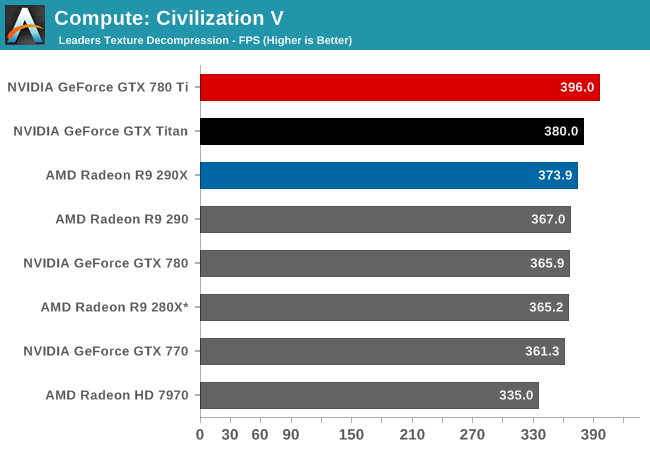
Even though we’re largely CPU bound by this point, GTX 780 Ti manages to get a bit more out of Civilization V’s texture decode routine, pushing it to the top of the charts and ahead of both GTX Titan and 290X.
Our next benchmark is LuxMark2.0, the official benchmark of SmallLuxGPU 2.0. SmallLuxGPU is an OpenCL accelerated ray tracer that is part of the larger LuxRender suite. Ray tracing has become a stronghold for GPUs in recent years as ray tracing maps well to GPU pipelines, allowing artists to render scenes much more quickly than with CPUs alone.
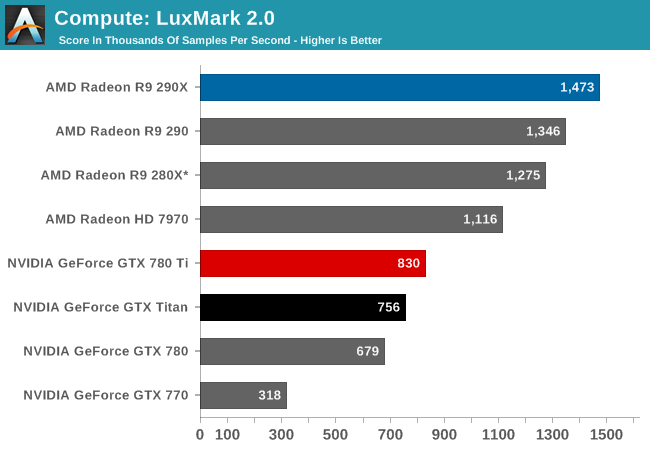
With LuxMark NVIDIA’s ray tracing performance sees further improvements due to the additional compute resources at hand. But NVIDIA still doesn’t fare well here, with the GTX 780 Ti falling behind all of our AMD cards in this test.
Our 3rd compute benchmark is Sony Vegas Pro 12, an OpenGL and OpenCL video editing and authoring package. Vegas can use GPUs in a few different ways, the primary uses being to accelerate the video effects and compositing process itself, and in the video encoding step. With video encoding being increasingly offloaded to dedicated DSPs these days we’re focusing on the editing and compositing process, rendering to a low CPU overhead format (XDCAM EX). This specific test comes from Sony, and measures how long it takes to render a video.

Like LuxMark, GTX 780 Ti once again improves on its predecessors. But it’s not enough to make up for AMD’s innate performance advantage in this benchmark, leading to GTX 780 Ti trailing all of the AMD cards.
Our 4th benchmark set comes from CLBenchmark 1.1. CLBenchmark contains a number of subtests; we’re focusing on the most practical of them, the computer vision test and the fluid simulation test. The former being a useful proxy for computer imaging tasks where systems are required to parse images and identify features (e.g. humans), while fluid simulations are common in professional graphics work and games alike.
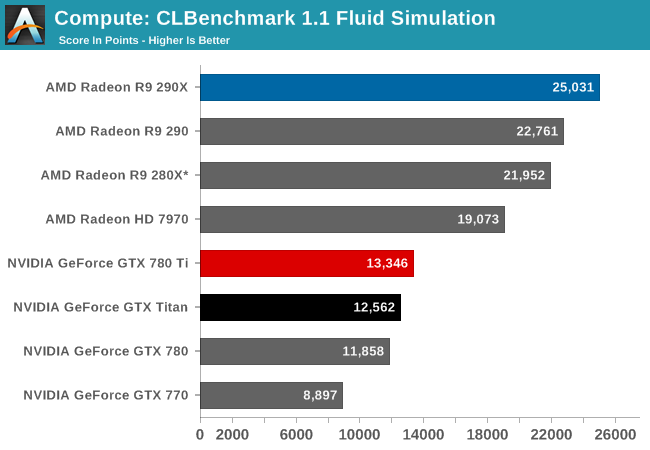
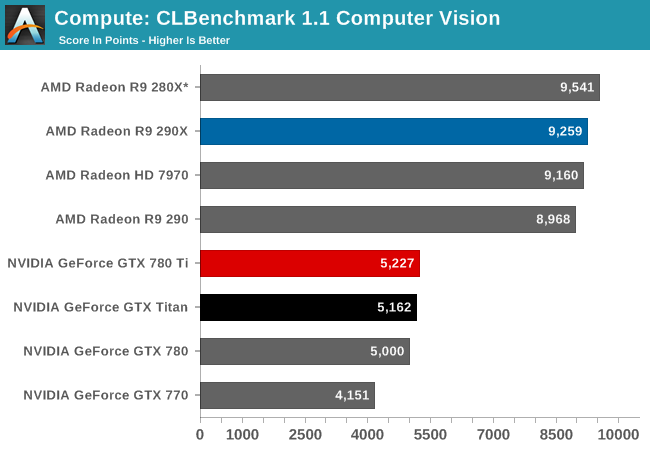
CLBenchmark continues to be the same story. GTX 780 Ti improves on NVIDIA’s performance to become their fastest single precision card, but it still falls short of every AMD card in these tests.
Moving on, our 5th compute benchmark is FAHBench, the official Folding @ Home benchmark. Folding @ Home is the popular Stanford-backed research and distributed computing initiative that has work distributed to millions of volunteer computers over the internet, each of which is responsible for a tiny slice of a protein folding simulation. FAHBench can test both single precision and double precision floating point performance, with single precision being the most useful metric for most consumer cards due to their low double precision performance. Each precision has two modes, explicit and implicit, the difference being whether water atoms are included in the simulation, which adds quite a bit of work and overhead. This is another OpenCL test, as Folding @ Home has moved exclusively to OpenCL this year with FAHCore 17.

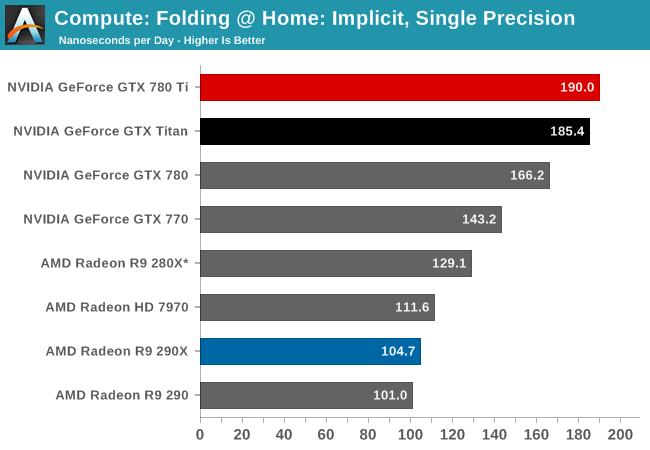
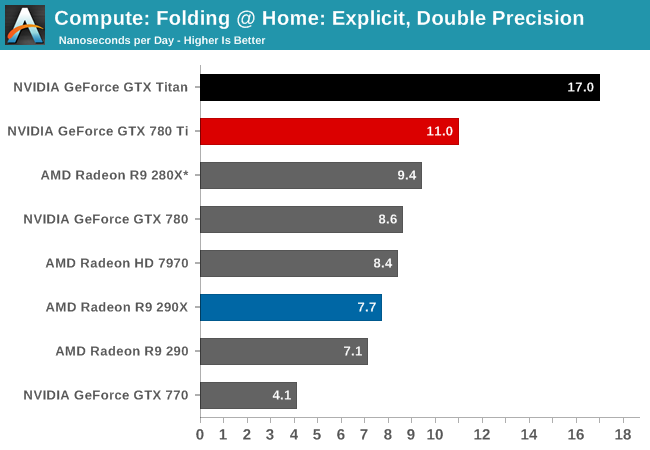
Finally with Folding@Home we see the GTX 780 Ti once again take the top spot. In the single precision tests the GTX 780 further extends NVIDIA’s lead, beating GTX Titan by anywhere between a few percent to over ten percent depending on which specific test we’re looking at. However even with GTX 780 Ti’s general performance increase, in the double precision test it won’t overcome the innate double precision performance deficit it faces versus GTX Titan. When it comes to double precision compute, Titan remains king.
Wrapping things up, our final compute benchmark is an in-house project developed by our very own Dr. Ian Cutress. SystemCompute is our first C++ AMP benchmark, utilizing Microsoft’s simple C++ extensions to allow the easy use of GPU computing in C++ programs. SystemCompute in turn is a collection of benchmarks for several different fundamental compute algorithms, as described in this previous article, with the final score represented in points. DirectCompute is the compute backend for C++ AMP on Windows, so this forms our other DirectCompute test.
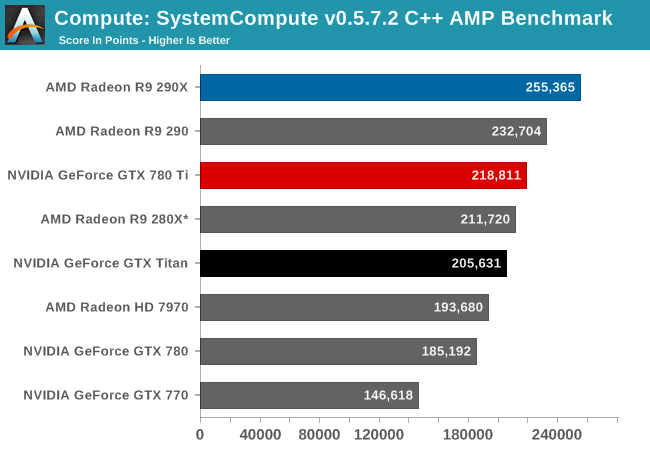
Last, in our C++ AMP benchmark we see the GTX 780 Ti take the top spot for an NVIDIA card, but like so many of our earlier compute tests it will come up short versus AMD’s best cards. This isn’t quite as lopsided as some of our other tests, however GTX 780 Ti is stuck competing with the 280X while the 290 and 290X easily outperform NVIDIA’s new flagship.










302 Comments
View All Comments
mohammadm5 - Monday, November 11, 2013 - link
http://www.aliexpress.com/item/Wholesale-Price-GeF...thats the wholesale price its not nvidia that charges so much is the resellers. the profit nvidia makes per gpu is very low but the reseller make alot of money, also the new amd r9 290 is going for $255 per unit at wholesale price and the r9 280x is going for $160 dollar per unit. you have to also remember thats the distributer price not the manufacturer price,witch should be alot lower. i know the gtx 780 at manufacturer price sells from $200 to $280 depending on brand.
so remember this is america were they sell you something made in china for 1 dollar for 10 dollars
UpSpin - Monday, November 11, 2013 - link
While those numbers are interesting, your conclusion is wrong. The $700 are what NVidia wants the customer to pay for the card, not what the reseller wants:http://nvidianews.nvidia.com/Releases/NVIDIA-Unvei...
"Pricing is expected to start at $699"
So it's not the seller who makes 100% profit, it's NVidia.
polaco - Monday, November 11, 2013 - link
remember that the reseller has to buy the card, pay import taxes, transportation and others, try to sell it and if the card goes unsold they have to sell it in a few month at discounts prices. Also in the case of psychical stores they have to keep building costs, employees, more taxes, etc. So what you are describing happens in every industry. Also and maybe in first place where are you getting those numbers from?Wade_Jensen - Monday, November 11, 2013 - link
OK, so either Brian has lost his Nexus 5 or its benchmark boosting, cause something has to be going on here.beck2448 - Monday, November 11, 2013 - link
Wow oc results are impressive. Where are the Lightning and Windforce versions?r13j13r13 - Tuesday, November 12, 2013 - link
la ventaja frente a una 290x es mínima pero la diferencias de precio no cuando se mejore la refrigeración de la 290x, al fin y al cabo la competencia nos beneficia a todosjukkie - Tuesday, November 12, 2013 - link
HD7990 can be gotten for as low as £400 in the UK at the moment (or £480 with a PSU or a M/B), so anyone wanting the ultimate in single CARD performance would bet better off buying that anyway.Obviously noise and heat will still be an issue, but if you're going to ignore the GTX 780 Ti's price, we can ignore those factors (thankfully microstuttering is mostly a non-issue these days since frame pacing has resolved that in everything except DX9 for now).
If the price of the 780 Ti were to drop 10-20%, I'd consider buying one, but as it is I simply can't justify it, even if affording it isn't a problem.
arjunp2085 - Wednesday, November 13, 2013 - link
Anand / RyanI would love to see a comparison of the 290 , 290x 780, 780 Ti with water coolers working efficiently. I believe that anyone spending $600 on a Gfx card would be able to spend an additional 100-200$ for a cool setup.
Further i would love to see if there is any performance increase due to increased cooling( With respect to boost states both Nv and AMD.
Any comments please let me know
Thanks,
Arjun
GUNN3R - Friday, November 29, 2013 - link
Is there an update in scores with latest drivers?Hrel - Sunday, January 12, 2014 - link
I really wish you guys had included useful resolutions. You realize the VAST majority of people, even enthusiasts, have 1080p screens right?You can do ur uber testing for your own personal concerns but it should be standing policy to include 1080p testing for everything. That's the resolution of screen that people have.